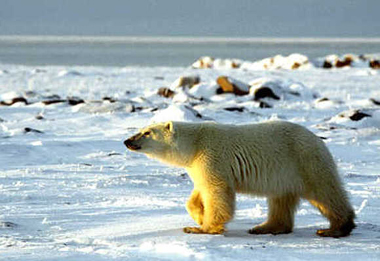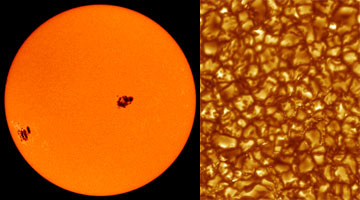Slender hoses, blown into arcs by the wind, partially fill the balloon with helium before launch. A large portion of the balloon is left unfilled so it can expand as it ascends into the stratosphere, where air pressure is considerably lower.
Click on image for full size
Photo by Carlye Calvin, ©UCAR.
Solar Telescope Reaches 120,000 Feet on Jumbo-Jet-Sized Balloon
News story originally written on October 24, 2007
The Sunrise project just had a successful first launch. This project is a huge balloon bigger then a 747 jumbo jet that carries science instruments very, very high in
the Earth's atmosphere.
This first launch was made from New Mexico and stayed up for about 10 hours. The next flights will be made
over the Arctic in the summer of 2009, launching from Sweden. Then the balloon will stay up for several days to as long as two weeks at a time.
The main aims of these launches are for the science instruments to take pictures of the Sun's surface and to look into the Sun's magnetic field. The magnetic field of the Sun is tied to solar activity which can cause storms that hit Earth.
The Sunrise project was a hard one to design and make. Engineers had to design a balloon that could carry 6,000 pounds of equipment. The equipment also had to be able to parachute back to Earth so scientists could pick it up and launch it on another balloon. The equipment had to handle big changes in temperature too. Working together, engineers and scientists tackled these problems and more!
Would you like to be an engineer some day tackling problems like these?
The Sunrise project has many partners including the National Center for Atmospheric Research (NCAR) and NASA.
You might also be interested in:

In the Arctic, you will find the Arctic Ocean surrounded by the continents of Europe, Asia, and North America. You will find the geographic North Pole and the magnetic North Pole there; both are in the
...more
Most of the energy we receive from the Sun is the visible (white) light emitted from the photosphere. The photosphere is one of the coolest regions of the Sun (6000 K), so only a small fraction (0.1%)
...more
Text for this level has not been written yet. Please see the "Intermediate" text for this page if you want to learn about this topic. To get to the "Intermediate" text, click on the blue "Intermediate"
...more
Scientists have learned that Mount Hood, Oregon's tallest mountain, has erupted in the past due to the mixing of two different types of magma. Adam Kent, a geologist at Oregon State University, says this
...more
The Earth's mantle is a rocky, solid shell that is between the Earth's crust and the outer core. The mantle is made up of many different reservoirs that have different chemical compositions. Scientists
...more
Some faults look strong and like they wouldn’t cause an earthquake. But it turns out that they can slip and slide like weak faults causing earthquakes. Scientists have been looking at one of these faults
...more
The sun goes through cycles that last approximately 11 years. These solar cycle include phases with more magnetic activity, sunspots, and solar flares. They also include phases with less activity. The
...more















